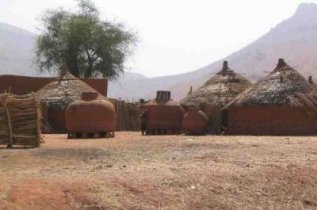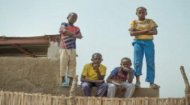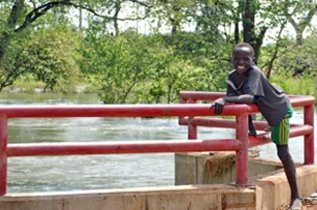
|
Normally, the foundation of a child’s experience in Chad rests firmly within the family structure, with extended family not just a concept, but an essential safety net where governmental services often fail. Children are typically raised within a communal environment, learning traditional roles and responsibilities early on. Whether in the nomadic communities of the Sahel (see the video below), the agricultural villages of the south, or the increasingly dense urban areas like N’Djamena, respect for elders and participation in household duties are paramount. The physical reality of their homes varies widely; while urban families may live in concrete structures, the majority reside in traditional compounds utilising locally available materials with round homes made of dried clay bricks mixed with a cone-shaped roof also made of straw. These living spaces are frequently basic, often lacking modern conveniences, but they serve as the central hub for learning, sharing resources, and maintaining cultural cohesion. However, the rapidly expanding population and volatile climate conditions mean that stable housing is an ongoing challenge for millions.
Compounding the healthcare crisis is the acute lack of safe water and sanitation access. For many children in Chad, simply obtaining water is a daily chore that consumes hours, often requiring journeys to distant, unprotected sources that harbour pathogens. Only a tiny fraction of the population, particularly in rural areas, has access to improved sanitation facilities. This deficiency fuels the cycle of disease, particularly cholera, typhoid, and various parasitic infections, which not only kill children but also stunt the development of those who survive. When a child is constantly battling illness due to contaminated water, their ability to attend school and thrive developmentally is severely compromised, trapping families in generational poverty. Children in Chad know that it is unlikely that they will grow old, with a life expectancy of just 55.07 years (2025). Furthermore, access to quality education remains a significant hurdle limiting future life opportunities. While primary school enrollment has increased, dropout rates are high, especially for girls. The system faces immense pressure: chronic shortages of qualified teachers, lack of basic materials like textbooks, and overcrowded, often dilapidated, classrooms are the norm. In some regions, a single teacher may be responsible for dozens of children across multiple grade levels. Cultural expectations also play a role; boys may be pulled out of school to help with herding or farming, while girls are frequently withheld to assist with domestic duties or due to preparation for early marriage. Consequently, literacy and numeracy rates for adolescents remain low, making the leap to higher education or skilled employment extremely difficult. |
Children in Chad |
Children in Chad |
Children in Chad | Children in Chad |
Explore all about the African nation of the Republic of Chad in a series of pictures, videos and images.
More >
|
|

|
For those children in Chad who do attend education, it's a walk to the nearest village school made of clay walls with a tin roof, with classrooms of one teacher with around seventy other pupils. Education for children in Chad is compulsory between ages 6 and 12, with primary education lasting for six years. At the end of this period, the Le Certificat d'Études Primaires (CEP) determines whether students are promoted to secondary school or go to technical or vocational school instead.
The vulnerability inherent in poverty and political instability exposes many children in Chad to harrowing forms of child exploitation. Child labour is widespread, with children working in gold mines, brick yards, agriculture, and as domestic servants, often starting before the age of ten. These children are generally unpaid or receive meagre compensation, losing their chance at an education and risking serious physical harm. Early marriage, particularly for girls, is another pervasive form of exploitation, robbing them of their childhood and increasing health risks associated with early pregnancy. Moreover, Chad’s geopolitical situation - bordering unstable regions - means that children are frequently displaced by conflict, making them susceptible to trafficking, arbitrary detention, and, tragically, recruitment into armed groups, adding an extra layer of trauma and danger to their already challenging lives. Chad is known as a source of child trafficking, both internally, where they are used as domestic slaves, as beggars, as cattle herders, or to help the fishermen, and also externally to countries such as Cameroon and the Central African Republic for similar tasks, as well as sexual exploitation. Despite all of this, life goes on for children in Chad. They rise at around 6 am with a breakfast often made from millet paste left over from the night before, mixed with milk. After breakfast, it's time for children in Chad to undertake their daily chores. Boys will shepherd the family goats and cattle when younger, then, when older, help their fathers in the fields with sowing or harvesting. Girls undertake household duties and help take care of younger brothers and sisters, with most Chadian women having 6.12 children (2025), as well as fetching water from the local source. After this education or work and after more chores, most children in Chad will have a bit of spare time. Play for children in Chad often demonstrates remarkable ingenuity and creativity, transforming everyday objects into sources of joy. Simple pastimes involving found materials - tyres rolled with sticks, handmade rag dolls, footballs crafted from plastic bags tightly bound with string—dominate their free time. Other popular activities include football or other games such as skipping or hopscotch. By 6 pm, the sun is setting, and it's time for an evening meal of millet paste with sauce, then bed by 8 pm, ready for another day. The video above shows aspects of life for children in Chad, together with projects and programs supporting children in the country. |

 One of the most immediate and severe challenges impacting children in Chad is the lack of adequate healthcare. Chad ranks near the bottom globally for health indicators, meaning that preventable diseases claim far too many young lives. High neonatal and infant mortality rates persist due to factors related to malnutrition, limited access to professional birth attendance, and the prevalence of infectious diseases like malaria and respiratory infections. While the government and international organisations strive to expand vaccination campaigns and rural clinics, the infrastructure is chronically weak. Many rural families must travel long distances to reach any functioning dispensary, and the cost of necessary medications often places them agonisingly out of reach.
One of the most immediate and severe challenges impacting children in Chad is the lack of adequate healthcare. Chad ranks near the bottom globally for health indicators, meaning that preventable diseases claim far too many young lives. High neonatal and infant mortality rates persist due to factors related to malnutrition, limited access to professional birth attendance, and the prevalence of infectious diseases like malaria and respiratory infections. While the government and international organisations strive to expand vaccination campaigns and rural clinics, the infrastructure is chronically weak. Many rural families must travel long distances to reach any functioning dispensary, and the cost of necessary medications often places them agonisingly out of reach.







 Those who are successful in their exam can then attend seven years of secondary education between the ages of 12-19, studying maths, science, history and geography, culminating in the Baccalauréat de l'Enseignement Supérieur. The first six years of education are technically free; however, ever as, parents are expected to pay for materials and even teacher salaries so, after the first three or so years pass and what state subsidies there are dry up, most children also drop out of school. In 2023, Chad had a secondary school enrollment rate of 25.24%, which is lower than the global average and represents a recent increase from previous years. Despite efforts, the country's education system faces challenges, with low completion rates for lower secondary education (14.1% for girls and 24.2% for boys in 2021) with over half the population being illiterate. Factors contributing to poor attendance include dispersed populations, parental reluctance, and socioeconomic difficulties such as poverty and family responsibilities.
Those who are successful in their exam can then attend seven years of secondary education between the ages of 12-19, studying maths, science, history and geography, culminating in the Baccalauréat de l'Enseignement Supérieur. The first six years of education are technically free; however, ever as, parents are expected to pay for materials and even teacher salaries so, after the first three or so years pass and what state subsidies there are dry up, most children also drop out of school. In 2023, Chad had a secondary school enrollment rate of 25.24%, which is lower than the global average and represents a recent increase from previous years. Despite efforts, the country's education system faces challenges, with low completion rates for lower secondary education (14.1% for girls and 24.2% for boys in 2021) with over half the population being illiterate. Factors contributing to poor attendance include dispersed populations, parental reluctance, and socioeconomic difficulties such as poverty and family responsibilities.


